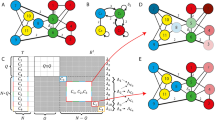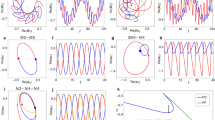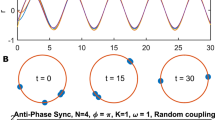Abstract
Oscillatory clusters are sets of domains in which nearly all elements in a given domain oscillate with the same amplitude and phase1,2,3,4. They play an important role in understanding coupled neuron systems5,6,7,8. In the simplest case, a system consists of two clusters that oscillate in antiphase and can each occupy multiple fixed spatial domains. Examples of cluster behaviour in extended chemical systems are rare, but have been shown to resemble standing waves9,10,11,12,13, except that they lack a characteristic wavelength. Here we report the observation of so-called ‘localized clusters’—periodic antiphase oscillations in one part of the medium, while the remainder appears uniform—in the Belousov–Zhabotinsky reaction–diffusion system with photochemical global feedback. We also observe standing clusters with fixed spatial domains that oscillate periodically in time and occupy the entire medium, and irregular clusters with no periodicity in either space or time, with standing clusters transforming into irregular clusters and then into localized clusters as the strength of the global negative feedback is gradually increased. By incorporating the effects of global feedback into a model of the reaction, we are able to simulate successfully the experimental data.
This is a preview of subscription content, access via your institution
Access options
Subscribe to this journal
Receive 51 print issues and online access
$199.00 per year
only $3.90 per issue
Buy this article
- Purchase on Springer Link
- Instant access to full article PDF
Prices may be subject to local taxes which are calculated during checkout




Similar content being viewed by others
References
Golomb, D., Hansel, D., Shraiman, B. & Sompolinsky, H. Clustering in globally coupled phase oscillators. Phys. Rev. A 45, 3516–3530 (1992).
Hakim, V. & Rappel, W.-J. Dynamics of the globally coupled complex Ginzburg-Landau equation. Phys. Rev. A 46, 7347–7350 (1992).
Falcke, M., Engel, H. & Neufeld, M. Cluster formation, standing waves, and stripe patterns in oscillatory active media with local and global coupling. Phys. Rev. E 52, 763–771 ( 1995).
Wang, W., Kiss, I. Z. & Hudson, J. L. Experiments on arrays of globally coupled chaotic electrochemical oscillators: Synchronization and clustering. Chaos 10, 248–256 ( 2000).
Golomb, D. & Rinzel, J. Clustering in globally coupled inhibitory neurons. Physica D 72, 259– 282 (1994).
Terman, D. & Wang, D. Global competition and local cooperation in a network of neural oscillators. Physica D 81, 148–176 (1995).
Huerta, R., Bazhenov, M. & Rabinovich, M. I. Clusters of synchronization and bistability in lattices of chaotic neurons. Europhys. Lett. 43, 719–724 (1998).
Rabinovich, M. I., Varona, P. & Torres, J. J. Slow dynamics and regularization phenomena in ensembles of chaotic neurons. Physica A 263, 405– 414 (1999).
Lev, O., Sheintuch, M., Pismen, L. M. & Yarnitzky, Ch. Standing and propagating wave oscillations in the anodic dissolution of nickel. Nature 336, 458–459 (1988).
Cordonier, G. A., Schuth, F. & Schmidt, L. D. Oscillations in methylamine decomposition on Pt, Rh, and Ir: Experiments and models. J. Chem. Phys. 91, 5374–5386 (1989).
Jakubith, S., Rotermund, H. H., Engel, W., von Oertzen, A. & Ertl, G. Spatiotemporal concentration patterns in a surface reaction: Propagating and standing waves, rotating spirals, and turbulence. Phys. Rev. Lett. 65, 3013– 3016 (1990).
Somani, M., Liauw, M. A. & Luss, D. Evolution and impact of temperature patterns during hydrogen oxidation on a Ni ring. Chem. Eng. Sci. 52 , 2331–2341 (1997).
Petrov, V., Ouyang, Q. & Swinney, H. L. Resonant pattern formation in a chemical system. Nature 388, 655–657 (1997).
Belousov, B. P. in Collection of Short Papers on Radiation Medicine 145– 152 (Medgiz, Moscow, 1959).
Zhabotinsky, A. M. Periodic liquid phase reactions. Proc. Acad. Sci. USSR 157, 392–395 (1964).
Zaikin, A. N. & Zhabotinsky, A. M. Concentration wave propagation in a two-dimensional, liquid phase self-oscillating system. Nature 225, 535–537 ( 1970).
Winfree, A. T. Spiral waves of chemical activity. Science 175, 634–636 (1972).
Ross, J., Müller, S. C. & Vidal, C. Chemical waves. Science 240, 460–465 (1988).
Kapral, R. & Showalter, K. (eds) Chemical Waves and Patterns (Kluwer, Dordrecht, 1995).
Kuhnert, L., Agladze, K. I. & Krinsky, V. I. Image processing using light-sensitive chemical waves. Nature 337, 244–247 (1989).
Grill, S., Zykov, V. S. & Müller, S. C. Feedback-controlled dynamics of meandering spiral waves. Phys. Rev. Lett. 75, 3368– 3371 (1995).
Kadar, S., Amemiya, T. & Showalter, K. Reaction mechanism for light sensitivity of the Ru(bpy)2+3-catalyzed Belousov-Zhabotinsky reaction. J. Phys. Chem. A 101, 8200–8206 (1997).
Yamaguchi, T., Kuhnert, L., Nagy-Ungvarai, Zs., Müller, S. C. & Hess, B. Gel systems for the Belousov-Zhabotinskii reaction. J. Chem. Phys. 95, 5831–5837 (1991).
Amemiya, T., Kettunen, P., Kadar, S., Yamaguchi, T. & Showalter, K. Formation and evolution of scroll waves in photosensitive excitable media. Chaos 8, 872– 878 (1998).
Zhabotinsky, A. M., Buchholtz, F., Kiyatkin, A. B. & Epstein, I. R. Oscillations and waves in metal-ion-catalyzed bromate oscillating reactions in highly oxidized states. J. Phys. Chem. 97, 7578–7584 (1993).
Bugrim, A., Dolnik, M., Zhabotinsky, A. M. & Epstein, I. R. Heterogeneous sources of target patterns in reaction-diffusion systems. J. Phys. Chem. 100, 19017–19022 (1996).
Gao, Y. & Försterling, H.-D. Oscillations in the bromomalonic acid/bromate system catalyzed by [Ru(bipy)3]2+. J. Phys. Chem. 99, 8638– 8644 (1995).
Acknowledgements
This work was supported by the Chemistry Division of the National Science Foundation and the W. M. Keck Foundation.
Author information
Authors and Affiliations
Corresponding author
Rights and permissions
About this article
Cite this article
Vanag, V., Yang, L., Dolnik, M. et al. Oscillatory cluster patterns in a homogeneous chemical system with global feedback. Nature 406, 389–391 (2000). https://doi.org/10.1038/35019038
Received:
Accepted:
Issue Date:
DOI: https://doi.org/10.1038/35019038
This article is cited by
-
Pattern-Selective Feedback Stabilization of Ginzburg–Landau Spiral Waves
Archive for Rational Mechanics and Analysis (2022)
-
Delayed Transcritical Bifurcation Induced Mixed Bursting in a Modified SM System with Asymmetrically Distributed Equilibria
Brazilian Journal of Physics (2021)
-
Transition from spiral wave chimeras to phase cluster states
Scientific Reports (2020)
-
Bursting oscillations with boundary homoclinic bifurcations in a Filippov-type Chua’s circuit
Pramana (2020)
-
Complex pattern formation arising from wave instabilities in a three-agent chemical system with superdiffusion
Journal of Mathematical Chemistry (2019)
Comments
By submitting a comment you agree to abide by our Terms and Community Guidelines. If you find something abusive or that does not comply with our terms or guidelines please flag it as inappropriate.



